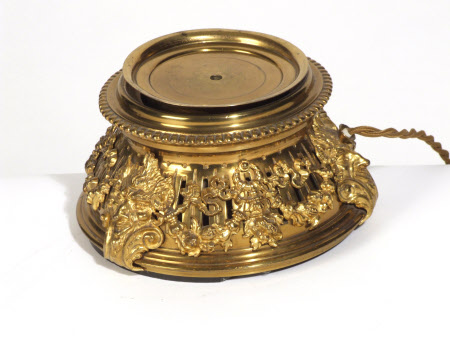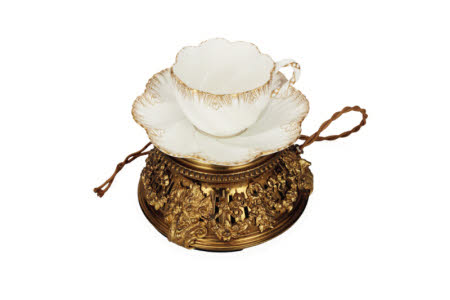Cup warmer
Category
Historic Services / Food & drink preparation
Date
1920 - 1930
Materials
Brass
Measurements
102 mm (Height); 203 mm (Diameter)
Order this imageCollection
Castle Drogo, Devon
NT 902809
Caption
In 1910 entrepreneur and millionaire Julius Drewe (1856–1931) commissioned architect Sir Edwin Lutyens (1869–1944) to design Castle Drogo, the last castle to be built in England. There was nothing medieval about the technology though: Drewe’s castle had central heating, numerous bathrooms, a telephone system, a lift and its own electricity supply. The dining table was even fitted with an electric tablecloth, which powered electric candlesticks. Electric tablecloths were among many novelties – some of them potentially lethal – associated with the early years of electricity in the home. This wonderful brass cup warmer was another of Drewe’s gadgets, designed to keep his cup of tea hot. Unlike earlier food warmers, which were powered by fire or candle flame, this device was plugged into one of the castle’s 332 electrical sockets and powered by hydroelectricity, generated in the valley below. Drewe had begun work as a tea merchant in China and opened the Willow Pattern Tea Store in Liverpool in 1878. In 1883 he founded the Home and Colonial Stores grocery chain, which specialised in tea from India and was so successful that he was able to retire at the age of 33.
Summary
An electric cup warmer with a brass base in a grotesque style.
Full description
Food warmers have been used for centuries to keep meals warm. Some earthenware and metal food warmers were used in the home, while others evolved for use on the move (like the modern camping stove) or in hospitals. From the 18th century a number of European porcelain factories produced food warmers, including tin-glazed earthenware ‘tea warmers’– a tea pot which rested on a stand, fitted with space for a candle or burner to keep the teapot contents warm. As the thirst for tea grew, so did the variety of materials available for tea wares, from ceramics and glass to electroplated metals. Cheap mass-manufacturing in the 19th century enabled the production of a huge variety of shapes and designs, including warmers for an individual cup. As electricity was introduced to British homes from the late 19th century, there was a rise in the number of new electric household appliances and gadgets, from vacuum cleaners and fridges to electric irons and toasters. In the early 20th century electric cup warmers or heaters like this one begin to appear in adverts. Tea played an important role in the life of owner of Castle Drogo, Julius Drewe (1856–1931). At the age of 18 he was sent to China as a tea-buyer by his uncle Francis Peek (of Liverpool tea-merchants Peek and Winch). In 1878, Drewe returned to Liverpool and opened the Willow Pattern Tea Store. In 1883, he and John Musker (1846–1926) founded the Home and Colonial Trading Association, later Home and Colonial Stores. This sold teas selected in India by Drewe, alongside other groceries, and was so successful that Drewe was able to retire aged 33. He used his accumulated wealth to build the magnificent Castle Drogo, complete with modern conveniences including a custom-built kitchen, telephones and electrical gadgets. Drewe commissioned Gilbert Gilkes and Co. (an engineering company specialising in hydro-electricity generation) to install two turbines on the river Teign, which generated the electrical supply for the castle. Drewe brought electric gadgets from his previous home, Wadhurst Hall, including an electric tablecloth, with a set of candlesticks converted for electricity (NT 904056). The cloth would have had a series of wires between layers of fabric. It was laid beneath the damask table cloth and plugged in. Electrical pins beneath the candlesticks pricked through the cloths to connect with the wiring. Drewe’s daughter Frances remembered that he was very proud of it. It worked well - but if liquid was spilled it caused ‘a brief panic in case the moisture short-circuited the cloth and blew the fuses;’
Provenance
This item forms part of the original Drewe family collection at Castle Drogo. It was transferred to the National Trust in 1988.
Marks and inscriptions
n

